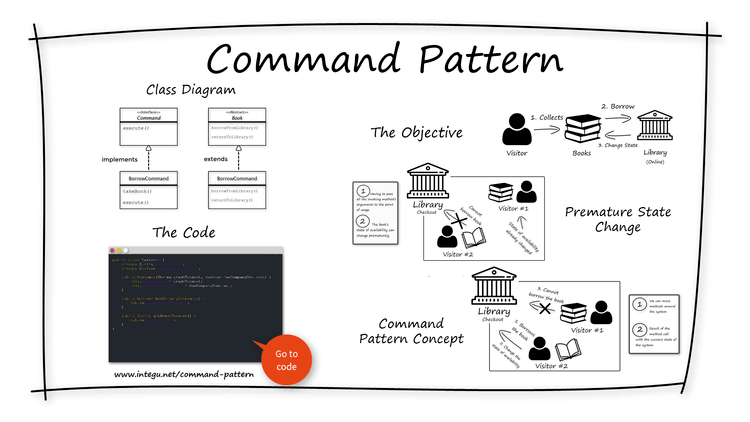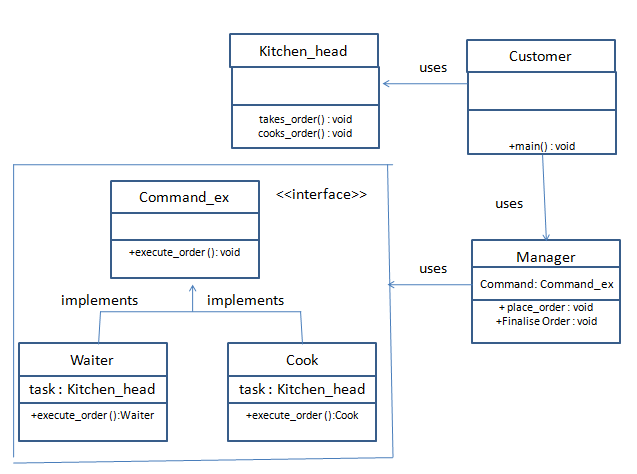Table Of Content

Since we can use System class to get the operating system information, we will use this or else we can use Factory pattern to return appropriate type based on the input. The Command pattern suggests that GUI objects shouldn’t send these requests directly. The Invoker, often a remote control, is the one responsible for initiating command execution.
Structural code in C#
The goal is to create a flexible remote control that can handle different types of commands for each device, such as turning devices on/off, adjusting settings, or changing channels. Concrete Command Classes are the specific commands, like turning on a TV or adjusting the stereo volume. Each class encapsulates the details of a particular action.
Command Pattern

First, create an interface named ICommand.cs and copy and paste the following code. We declare one method (i.e., Execute) in this ICommand interface, which executes a command. The similar approach is adapted into chain of responsibility pattern as well.
Command Pattern Interface and Implementations
Create a class file named Document.cs and copy and paste the following code. Here, we created the receiver class with three methods, i.e., Open, Save, and Close. The Receiver class contains the business logic to perform the actual actions. The following methods will be executed whenever the Invoker calls the Execute Method on the command object.
The Command Design Pattern is a behavioral design pattern that revolutionizes the way requests are handled in software development. By encapsulating a request as an object, this pattern empowers developers to parameterize clients with diverse requests, efficiently queue and log requests, and seamlessly support undoable operations. In command pattern, the request is send to the invoker and invoker pass it to the encapsulated command object. Command object passes the request to the appropriate method of Receiver to perform the specific action.
Some other Popular Design Patterns
CommandPatternDemo, our demo class, will use Broker class to demonstrate command pattern. CommandAn interface declared with an execute() method that individual commands would implement. It can also have an unexecute() method for unexecuting the last executed operation. For the sake of simplicity, we leave unexecute() out of the picture and focus just on the execute() method.
Implementation Details
As you can see in the below image, the client will create the command object. First, the Command Object has the Request (i.e., what to do?). The Receiver Object is nothing but the object which will handle the request. The Execute method will call the receiver object method, and the receiver object method will handle the request. The Command Design Pattern is particularly useful when you need to issue requests to objects without knowing anything about the operation being requested or the receiver of the request. It’s also beneficial when you need to parameterize objects with operations, and when you need to queue, specify, and execute requests at different times.
Later, the string can be restored as the initial command object. In the same way, you can queue, log or send commands over the network. Other GUI elements, such as menus, shortcuts or entire dialogs, can be implemented in the same way. They’ll be linked to a command which gets executed when a user interacts with the GUI element. As you’ve probably guessed by now, the elements related to the same operations will be linked to the same commands, preventing any code duplication.
Specifically, the invoker object is a higher-order function of which the command object is a first-class argument. Now we create the Invoker class and assign all the commands it can execute. The Invoker accepts the concrete command instances as the constructor parameters. The public methods of the Invoker are configured to call the execute() method of the respective commands. Command design patterns have a few core participants such as Invoker, Receiver, ConcreteCommand, etc., that are responsible for executing operations based on the client's request.
Your Wish is My Command: Giving Users the Power to Instruct their Software Henry Lieberman, editor - MIT Media Lab
Your Wish is My Command: Giving Users the Power to Instruct their Software Henry Lieberman, editor.
Posted: Sat, 17 Dec 2016 02:14:32 GMT [source]
Only difference is that in command there is one request handler, and in chain of responsibility there can be many handlers for single request object. Command Pattern is one of the Behavioral Design Pattern. Command design pattern is used to implement loose coupling in a request-response model.
If the Invoker calls the Execute method on the Open Command Object, then the Open Method of the Document Object will be executed. Similarly, if the Invoker calls the Execute method on the Save Command Object, then the Save Method of the Document Object will be executed. Concrete command classes implement the Command interface. Each class encapsulates a specific operation related to devices.
The Command Pattern is a behavioral design pattern that focuses on encapsulating a request as an object, thereby decoupling the sender of the request from the receiver. This pattern allows you to parameterize objects with commands, delay or queue a request’s execution, and support undoable operations. It’s a fundamental pattern for implementing a wide range of functionality in software systems. The frontend team is unaware of the action that will be executed when a button is clicked.
They only have a static representation without a runtime equivalent. If we would be able to store the history of all requests a user made, we could provide functionality like undo/redo or event let users record several actions to form a macro. Also, tracking bugs would be much easier - just record all steps the user took and iterate through them one by one to recreate the error state. We could even send a user action from one device to another and execute it there. Command is behavioral design pattern that converts requests or simple operations into objects. The central ideas of this design pattern closely mirror the semantics of first-class functions and higher-order functions in functional programming languages.
For recreating the deleted items, you have to reset the flag again. While relatively easy to implement initially, adding this mechanism to an existing code base may require some effort as you must update most of your queries. A class is a blueprint that describes the shape and behavior of an object. An object is an instance of a class created during runtime. If we want to know which objects exist in our application, we could store them in a list to keep track of them.
Its elegance lies in providing a flexible framework for orchestrating complex actions without the need for tight coupling. This C++14 implementation is based on the pre C++98 implementation in the book.

No comments:
Post a Comment